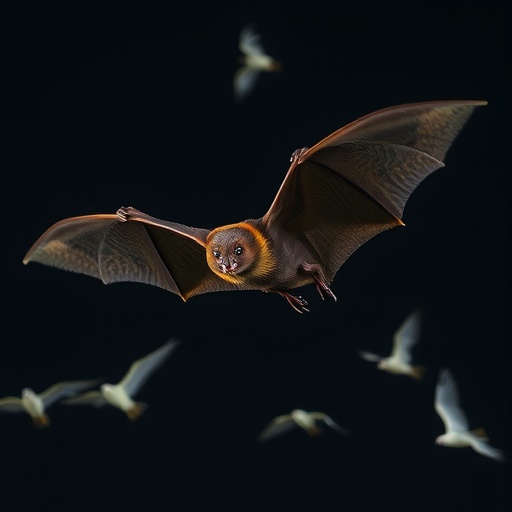In a groundbreaking exploration of predatory behavior among European bats, a team of scientists has unveiled the remarkable hunting strategies of the greater noctule bat (Nyctalus lasiopterus), Europe’s largest bat species. This research brings to light the extraordinary ability of these bats to capture, kill, and consume nocturnally migrating passerine birds mid-flight, high above the ground, exploiting a rich but underutilized food resource. The significance of this discovery lies not only in its contribution to our understanding of bat ecology but also in unveiling a complex aerial predation strategy previously undocumented with such direct evidence.
Billions of migratory birds seasonally traverse vast distances during the night, traveling at altitudes exceeding hundreds of meters. These immense flocks represent an abundant food resource; however, their aerial environment and the birds’ size and evasive capabilities render them challenging prey for many predators. Despite these difficulties, only a few bat species—most notably the greater noctule—have evolved to prey upon these birds in flight, an ability that diverges significantly from the insectivorous habits common among most bats.
Until now, direct observations of such high-altitude predation were scarce, predominantly inferred from indirect evidence like bird remains found in bat guano. This knowledge gap raised critical questions about exactly how and where these bats conduct their hunt, and the mechanisms they employ to successfully capture and handle such formidable prey. Addressing this uncertainty, Laura Stidsholt and her collaborative research team embarked on an ambitious study using cutting-edge biologging technology to capture the elusive hunting behavior of greater noctules in unprecedented detail.
Equipping 14 wild greater noctule bats with lightweight, high-resolution biologging tags, the researchers collected comprehensive data on flight altitude, three-dimensional movement, and echolocation activity. This approach allowed the team to monitor the bats’ natural foraging behavior in real-time, offering rare insights into how these predators transition from insect hunting near the ground to pursuing larger bird prey higher in the night sky.
Notably, the tracked bats exhibited behavior markedly distinct from typical insectivorous foraging. Prior to initiating pursuit, the bats ascended rapidly to altitudes above 400 meters. From these elevated vantage points, they were able to visually and acoustically detect potential prey within vast nocturnal flocks. Upon identifying a target, the bats executed rapid, prolonged chase sequences characterized by aggressive diving and swift maneuvering, utilizing over 40 echolocation buzzes per attack to maintain precise tracking of individual birds amidst the complexity of flock movement.
Critically, of the two documented pursuits, one culminated in a successful capture of a European robin. Confirmation of this predation event was further substantiated by audio recordings captured by the biologgers, which documented the distress calls of the victim bird during the chase. Following the interception, the bat efficiently incapacitated its prey with a lethal bite, highlighting the precise predatory skills necessary to subdue an animal roughly comparable in size to the bat itself.
In a striking revelation, the study recorded continuous chewing sounds amid the echolocation calls, indicating that the greater noctule consumed its avian prey while still airborne. Remarkably, the bat maintained stable flight without altitude loss over a sustained 23-minute feeding interval. This aerial consumption behavior is exceptional among carnivorous bats, which generally perch to consume prey and contrasts sharply with raptors and other predators that must land to dismember large prey items.
Further mechanistic insights into prey handling were gained through an analysis of bird wing remains collected under known hunting territories. Utilizing predator DNA barcoding and X-ray imaging, the researchers identified distinctive bite marks originating from greater noctule bats. These marks suggest a strategic removal of the wings mid-flight, a behavior which would immobilize the prey, reduce aerodynamic drag, and facilitate easier handling and consumption during continuous flight. This technique bears resemblance to aerial hawking strategies observed in insectivorous bats, repurposed here for capturing and processing much larger vertebrate prey.
The aerodynamic and behavioral adaptations enabling the greater noctule to exploit this rich resource illuminate a fascinating example of evolutionary innovation in mammalian predation tactics. Their unique hunting strategy involves a combination of heightened sensory acuity, refined flight control, and specialized feeding behaviors that challenge prior assumptions about the dietary limitations of bats and the dynamics of nocturnal predator-prey interactions in aerial ecosystems.
Furthermore, this research underscores the ecological significance of predator-prey relationships extending into the aerial nocturnal environment, where few vertebrate predators operate. It broadens our understanding of food web complexity and energy flow in flying vertebrate communities, suggesting that the trophic impact of predation by greater noctule bats on migratory bird populations may be more substantial than previously recognized.
The study exemplifies the power of biologging technology to unlock hidden facets of animal behavior, providing nuanced, high-resolution data that redefines classical notions about species’ ecological niches. These findings open new avenues for further biomechanical and sensory investigations, with potential implications for conservation biology, particularly as migratory bird populations face increasing threats from habitat change and climate shifts.
Laura Stidsholt and colleagues have not only confirmed the extraordinary predatory behavior of the greater noctule bat but have also pioneered methodological advances that illuminate complex three-dimensional foraging strategies unique among mammals. This discovery reshapes our understanding of bat ecology and predation and highlights the intricate evolutionary arms race occurring high above us in the nocturnal skies.
Subject of Research: Predatory behavior and aerial hunting strategies of the greater noctule bat (Nyctalus lasiopterus) preying on nocturnally migrating passerine birds.
Article Title: Greater noctule bats prey on and consume passerines in flight
News Publication Date: 9-Oct-2025
Web References: 10.1126/science.adr2475
References: Laura Stidsholt et al., Science, 2025
Keywords: Greater noctule, Nyctalus lasiopterus, aerial predation, migratory birds, biologging, echolocation, bat ecology, passerines, nocturnal hunting, predator-prey interactions, flight biomechanics, animal behavior




